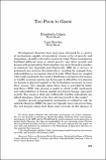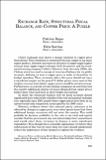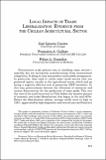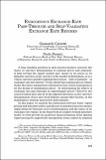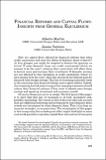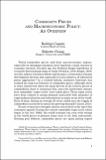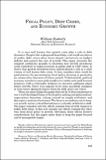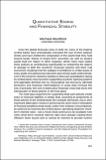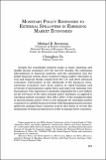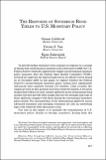Buscar
Mostrando ítems 51-60 de 135
Too poor to grow
Development theorists have long been intrigued by a variety of mechanisms capable of generating vicious cycles of poverty and stagnation—broadly referred to as poverty traps. These mechanisms highlight different ways in which poverty may deter growth and become self-perpetuating. Such situation may ...
Exchange rate structural fiscal balance and copper price: a puzzle
Chile’s exchange rate shows a strong volatility to copper price fluctuations. This correlation is essentially because copper is our main export product therefore increases in the price of copper imply higher returns from copper export volumes both for private and the stateowned mining company Codelco. ...
Local impacts of trade liberalization: evidence from the chilean agricultural sector
Protectionist trade policies aim at shielding some sectors— typically but not exclusively manufacturing—from international competition. In doing so they may produce unintended consequences. In particular they tend to create some taxed sectors that use protected inputs usually in the agricultural sector ...
Endogenous exchange-rate pass-through and self-validating exchange rate regimes
A long-standing question in open macroeconomics concerns the choice of currency denomination of nominal prices and contracts. A firm serving the export market may choose to set prices in its domestic currency in the currency of the market of destination or in a vehicle currency possibly indexing these ...
Financial reforms and capital flows: insights from general equilibrium
How are capital flows affected by financial reforms that relax credit constraints and raise the ability of domestic firms to borrow? At first glimpse one might be tempted to dismiss the question as trivial. If some domestic firms are credit constrained (which we assume to be the case!) relaxing their ...
Commodity prices and macroeconomic policy: and overview
World commodity prices and their macroeconomic impact especially on emerging economies have long been a main concern in economic research. Decades ago the Prebisch-Singer hypothesis of secularly deteriorating terms of trade (Prebisch 1950 Singer 1950) was the subject of intense debate and became a ...
Fiscal policy debt crises and economic growth
It is very well known that growth rates play a role in debt dynamics. Despite this widespread knowledge real world narratives of public debt crises often focus almost exclusively on budget deficits and neglect the role of growth. This paper presents the simplest arithmetic possible to illustrate how ...
Quantitative easing and financial stability
Since the global financial crisis of 2008–09 many of the leading central banks have dramatically increased the size of their balance sheets and have shifted the composition of the assets that they hold toward larger shares of longer-term securities (as well as toward assets that are riskier in other ...
Monetary policy responses to external spillovers in emerging market economies
Despite the remarkable progress made in many emerging and middle-income economies over the last few decades the continuing liberalization in financial markets and the integration into the global financial system these countries remain highly vulnerable to real and financial shocks coming from the U.S. ...
The response of sovereign bonds yields to U.S. monetary policy
To provide further stimulus to the economy in response to a cascade of shocks that roiled financial markets in the latter part of 2008 the U.S. Federal Reserve started to aggressively employ unconventional monetary policy measures after the Federal Open Market Committee (FOMC) lowered the target for ...

